2012 Hyundai H-100 Truck light
[x] Cancel search: lightPage 61 of 217
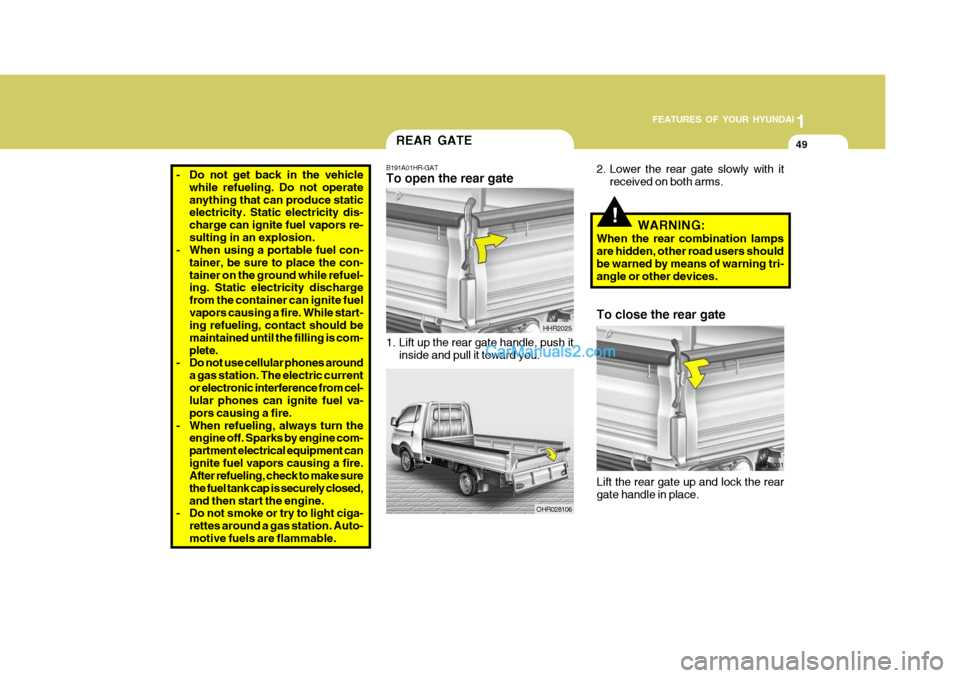
1
FEATURES OF YOUR HYUNDAI
49
!WARNING:
When the rear combination lamps are hidden, other road users shouldbe warned by means of warning tri- angle or other devices. To close the rear gate
Lift the rear gate up and lock the rear gate handle in place. HHR2031
2. Lower the rear gate slowly with it
received on both arms.
REAR GATE
B191A01HR-GAT To open the rear gate
HHR2025
1. Lift up the rear gate handle, push it inside and pull it toward you.
OHR028106
- Do not get back in the vehiclewhile refueling. Do not operate anything that can produce static electricity. Static electricity dis- charge can ignite fuel vapors re-sulting in an explosion.
- When using a portable fuel con-
tainer, be sure to place the con-tainer on the ground while refuel- ing. Static electricity discharge from the container can ignite fuelvapors causing a fire. While start- ing refueling, contact should be maintained until the filling is com-plete.
- Do not use cellular phones around
a gas station. The electric currentor electronic interference from cel- lular phones can ignite fuel va- pors causing a fire.
- When refueling, always turn the engine off. Sparks by engine com-partment electrical equipment canignite fuel vapors causing a fire. After refueling, check to make sure the fuel tank cap is securely closed,and then start the engine.
- Do not smoke or try to light ciga-
rettes around a gas station. Auto-motive fuels are flammable.
Page 69 of 217
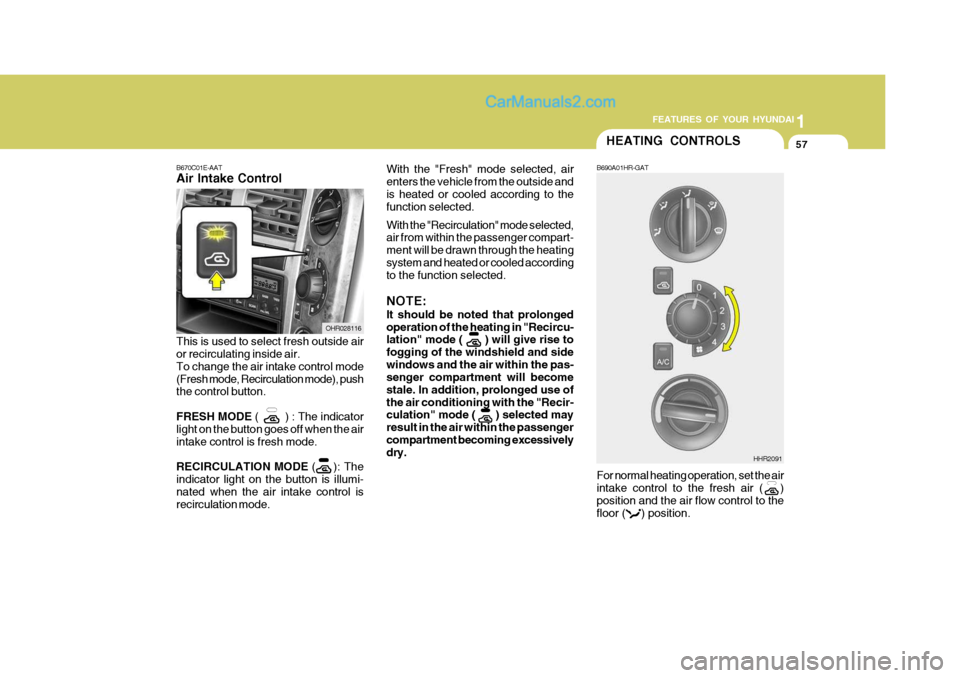
1
FEATURES OF YOUR HYUNDAI
57
With the "Fresh" mode selected, air enters the vehicle from the outside andis heated or cooled according to the function selected. With the "Recirculation" mode selected, air from within the passenger compart- ment will be drawn through the heatingsystem and heated or cooled according to the function selected. NOTE: It should be noted that prolonged operation of the heating in "Recircu- lation" mode ( ) will give rise to fogging of the windshield and sidewindows and the air within the pas- senger compartment will become stale. In addition, prolonged use ofthe air conditioning with the "Recir- culation" mode ( ) selected may result in the air within the passengercompartment becoming excessively dry.
B670C01E-AAT Air Intake Control
This is used to select fresh outside air or recirculating inside air. To change the air intake control mode(Fresh mode, Recirculation mode), push the control button. FRESH MODE ( ) : The indicator
light on the button goes off when the air intake control is fresh mode. RECIRCULATION MODE ( ): The
indicator light on the button is illumi- nated when the air intake control is recirculation mode. OHR028116B690A01HR-GAT For normal heating operation, set the air intake control to the fresh air ( ) position and the air flow control to thefloor ( ) position.
HHR2091
HEATING CONTROLS
Page 74 of 217

1FEATURES OF YOUR HYUNDAI
62
1
2
3
4
5
For dehumidified heating:
o Turn on the fan control switch (2).
o Turn on the air conditioning switch
(5). The air conditioning indicatorlight should come on at the sametime.
o Set the air intake control (4) to the
fresh air ( ) position.
o Set the air flow control (1) to the face ( ) position.
o Adjust the fan control (2) to the de- sired speed.
o For more rapid action, set the fan at
one of the higher speeds.
o Adjust the temperature control (3) to provide the desired amount ofwarmth.B740C01A-AAT De-Humidified Heating
To use the air conditioning to cool the interior:
o Turn on the fan control switch (2).
o Turn on the air conditioning switch
(5) by pushing in on the switch. The air conditioning indicator light should come on at the same time.
o Set the air intake control (4) to the
position.
o Set the temperature control (3) to
"Cool". ("Cool" provides maximum cooling. The temperature may be moderated by moving the control toward "Warm".)
o Adjust the fan control (2) to the de- sired speed. For greater cooling, turnthe fan control to one of the higherspeeds or temporarily select the
position on the air intake control.
B740C01HR
Page 84 of 217
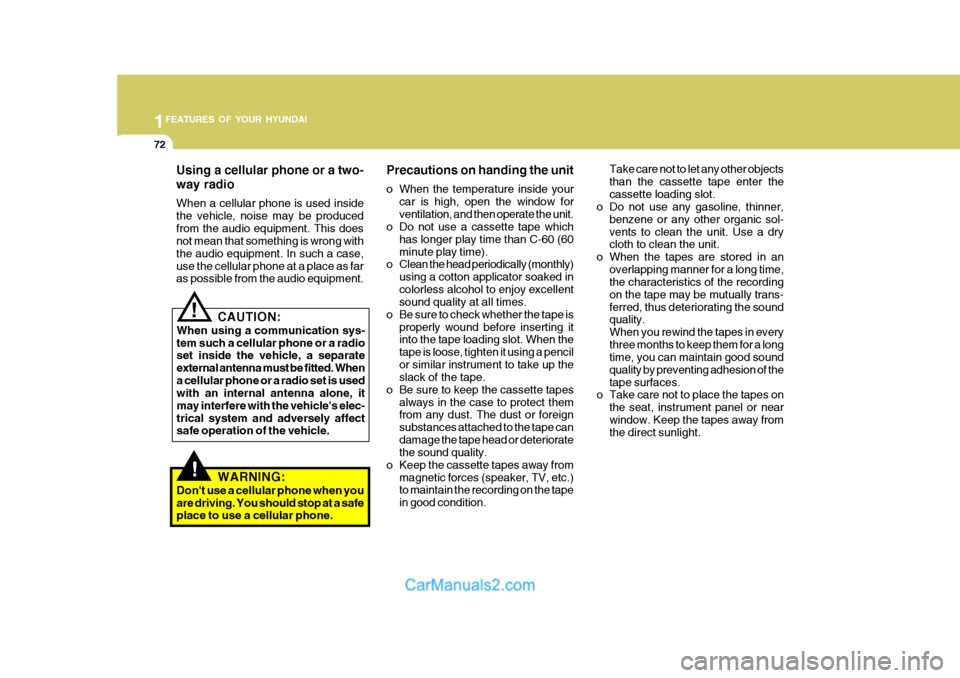
1FEATURES OF YOUR HYUNDAI
72
Using a cellular phone or a two- way radio When a cellular phone is used inside the vehicle, noise may be producedfrom the audio equipment. This does not mean that something is wrong with the audio equipment. In such a case,use the cellular phone at a place as far as possible from the audio equipment. Precautions on handing the unit
o When the temperature inside your
car is high, open the window for ventilation, and then operate the unit.
o Do not use a cassette tape which
has longer play time than C-60 (60minute play time).
o Clean the head periodically (monthly)
using a cotton applicator soaked incolorless alcohol to enjoy excellent sound quality at all times.
o Be sure to check whether the tape is properly wound before inserting itinto the tape loading slot. When the tape is loose, tighten it using a pencilor similar instrument to take up the slack of the tape.
o Be sure to keep the cassette tapes always in the case to protect themfrom any dust. The dust or foreign substances attached to the tape candamage the tape head or deteriorate the sound quality.
o Keep the cassette tapes away from magnetic forces (speaker, TV, etc.)to maintain the recording on the tape in good condition. Take care not to let any other objectsthan the cassette tape enter thecassette loading slot.
o Do not use any gasoline, thinner,
benzene or any other organic sol-vents to clean the unit. Use a dry cloth to clean the unit.
o When the tapes are stored in an overlapping manner for a long time,the characteristics of the recording on the tape may be mutually trans-ferred, thus deteriorating the sound quality. When you rewind the tapes in everythree months to keep them for a long time, you can maintain good sound quality by preventing adhesion of thetape surfaces.
o Take care not to place the tapes on
the seat, instrument panel or nearwindow. Keep the tapes away from the direct sunlight.
!
! CAUTION:
When using a communication sys- tem such a cellular phone or a radio set inside the vehicle, a separate external antenna must be fitted. Whena cellular phone or a radio set is used with an internal antenna alone, it may interfere with the vehicle's elec-trical system and adversely affect safe operation of the vehicle.
WARNING:
Don't use a cellular phone when you are driving. You should stop at a safe place to use a cellular phone.
Page 95 of 217
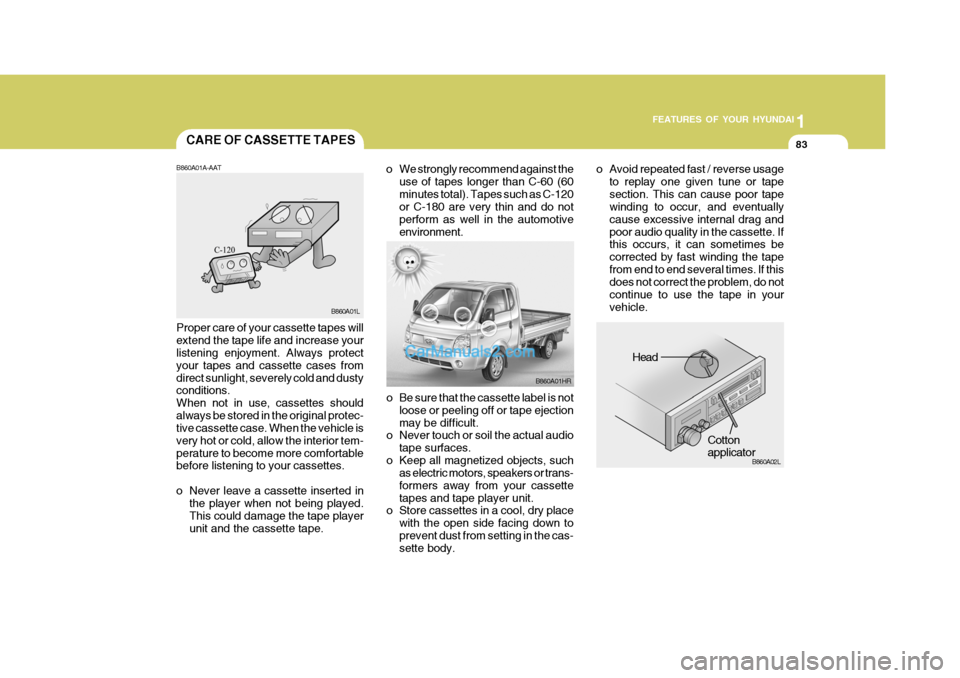
1
FEATURES OF YOUR HYUNDAI
83
o Be sure that the cassette label is not
loose or peeling off or tape ejection may be difficult.
o Never touch or soil the actual audio
tape surfaces.
o Keep all magnetized objects, such as electric motors, speakers or trans-formers away from your cassettetapes and tape player unit.
o Store cassettes in a cool, dry place
with the open side facing down toprevent dust from setting in the cas- sette body.
o We strongly recommend against the
use of tapes longer than C-60 (60 minutes total). Tapes such as C-120 or C-180 are very thin and do not perform as well in the automotiveenvironment. o Avoid repeated fast / reverse usage
to replay one given tune or tapesection. This can cause poor tape winding to occur, and eventually cause excessive internal drag andpoor audio quality in the cassette. If this occurs, it can sometimes be corrected by fast winding the tapefrom end to end several times. If this does not correct the problem, do not continue to use the tape in yourvehicle.
Head
Cotton applicator
B860A01HR
B860A02L
CARE OF CASSETTE TAPES
B860A01A-AAT Proper care of your cassette tapes will extend the tape life and increase your listening enjoyment. Always protect your tapes and cassette cases fromdirect sunlight, severely cold and dusty conditions. When not in use, cassettes shouldalways be stored in the original protec- tive cassette case. When the vehicle is very hot or cold, allow the interior tem-perature to become more comfortable before listening to your cassettes.
o Never leave a cassette inserted in the player when not being played. This could damage the tape playerunit and the cassette tape. B860A01L
Page 99 of 217

2
DRIVING YOUR HYUNDAI
3
!
BEFORE STARTING THE EN- GINE
C020A02A-AAT Before you start the engine, you should always:
1. Look around the vehicle to be sure
there are no flat tires, puddles of oil, water or other indications of pos- sible trouble.
2. After entering the car, check to be sure the parking brake is engaged.
3. Check that all windows, and lights are clean.
4. Check that the interior and exterior
mirrors are clean and in position.
5. Check your seat, seatback and headrest to be sure they are in theirproper positions.
6. Lock all the doors.
7. Fasten your seat belt and be sure
that all other occupants have fas- tened theirs.
8. Turn off all lights and accessories
that are not needed.
9. When you turn the ignition switch to "ON", check that all appropriatewarning lights are operating andthat you have sufficient fuel.
10.Check the operation of warning
lights and all bulbs when key is inthe "ON" position.
!WARNING:
To ensure that sufficient vacuum exists within the brake system dur-ing cold weather start-up condi- tions, it is necessary to run the engine at idle for several secondsafter starting the engine.
WARNING:
Always wear appropriate shoes when operating your vehicle. Unsuitable shoes (high heels, ski boots,etc.)may interfere with your ability to use the brake and accelerator pedal, and the clutch (if installed).!WARNING:
Driving while distracted can result in a loss of vehicle control, that may lead to an accident, severe personal
injury, and death. The driver’s pri-mary responsibility is in the safe and legal operation of a vehicle, and use of any handheld devices, otherequipment, or vehicle systems which take the driver’s eyes, attention and focus away from the safe operationof a vehicle or which are not permis- sible by law should never be used during operation of the vehicle.
Page 102 of 217
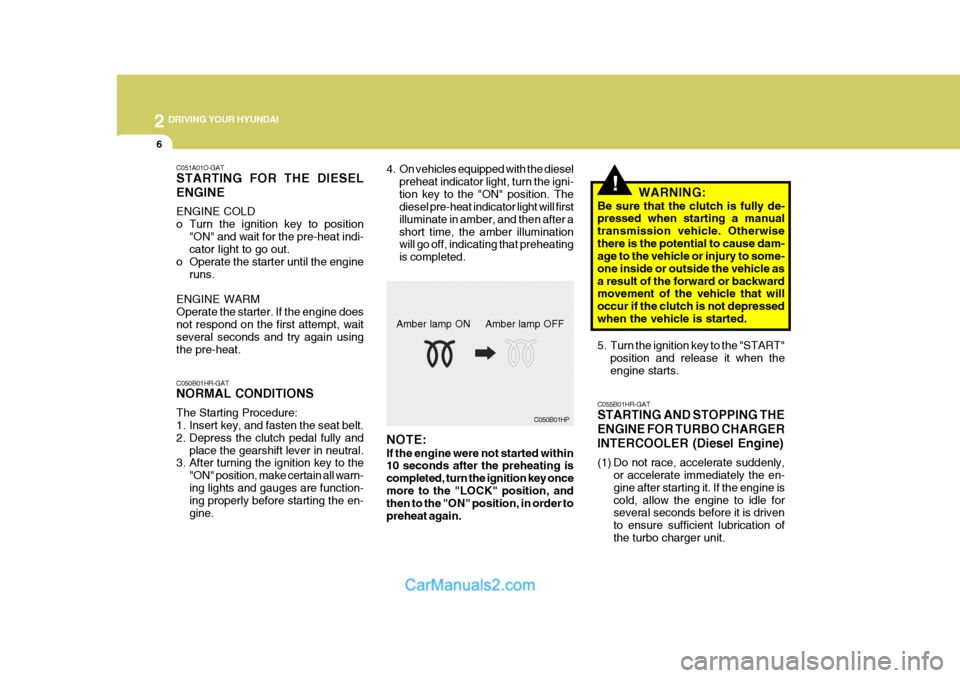
2 DRIVING YOUR HYUNDAI
6
!
C055B01HR-GAT STARTING AND STOPPING THE ENGINE FOR TURBO CHARGERINTERCOOLER (Diesel Engine)
(1) Do not race, accelerate suddenly,
or accelerate immediately the en- gine after starting it. If the engine iscold, allow the engine to idle for several seconds before it is driven to ensure sufficient lubrication ofthe turbo charger unit. WARNING:
Be sure that the clutch is fully de- pressed when starting a manual transmission vehicle. Otherwisethere is the potential to cause dam- age to the vehicle or injury to some- one inside or outside the vehicle asa result of the forward or backward movement of the vehicle that will occur if the clutch is not depressedwhen the vehicle is started.
5. Turn the ignition key to the "START" position and release it when the engine starts.
C050B01HP
NOTE: If the engine were not started within 10 seconds after the preheating is completed, turn the ignition key oncemore to the "LOCK" position, and then to the "ON" position, in order to preheat again. Amber lamp ON Amber lamp OFF
C051A01O-GAT STARTING FOR THE DIESEL ENGINE ENGINE COLD
o Turn the ignition key to position
"ON" and wait for the pre-heat indi- cator light to go out.
o Operate the starter until the engine
runs.
ENGINE WARM Operate the starter. If the engine does not respond on the first attempt, wait several seconds and try again usingthe pre-heat. C050B01HR-GAT NORMAL CONDITIONS The Starting Procedure:
1. Insert key, and fasten the seat belt.
2. Depress the clutch pedal fully and place the gearshift lever in neutral.
3. After turning the ignition key to the
"ON" position, make certain all warn-ing lights and gauges are function- ing properly before starting the en- gine. 4. On vehicles equipped with the diesel
preheat indicator light, turn the igni-tion key to the "ON" position. The diesel pre-heat indicator light will first illuminate in amber, and then after ashort time, the amber illumination will go off, indicating that preheating is completed.
Page 106 of 217
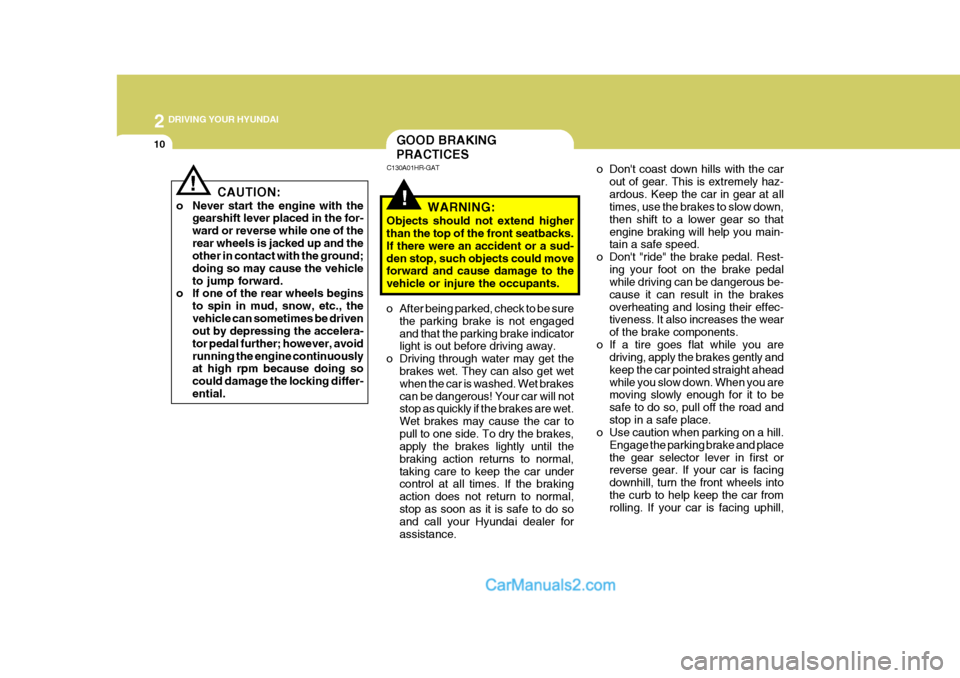
2 DRIVING YOUR HYUNDAI
10
o Don't coast down hills with the carout of gear. This is extremely haz- ardous. Keep the car in gear at all times, use the brakes to slow down, then shift to a lower gear so thatengine braking will help you main- tain a safe speed.
o Don't "ride" the brake pedal. Rest- ing your foot on the brake pedalwhile driving can be dangerous be- cause it can result in the brakesoverheating and losing their effec- tiveness. It also increases the wear of the brake components.
o If a tire goes flat while you are driving, apply the brakes gently and
keep the car pointed straight aheadwhile you slow down. When you are moving slowly enough for it to be safe to do so, pull off the road andstop in a safe place.
o Use caution when parking on a hill.
Engage the parking brake and place
the gear selector lever in first or reverse gear. If your car is facing downhill, turn the front wheels intothe curb to help keep the car from rolling. If your car is facing uphill,
!
GOOD BRAKING PRACTICES
C130A01HR-GAT
WARNING:
Objects should not extend higher than the top of the front seatbacks. If there were an accident or a sud-den stop, such objects could move forward and cause damage to the vehicle or injure the occupants.
o After being parked, check to be sure the parking brake is not engaged and that the parking brake indicator light is out before driving away.
o Driving through water may get the brakes wet. They can also get wet when the car is washed. Wet brakescan be dangerous! Your car will not stop as quickly if the brakes are wet. Wet brakes may cause the car to
pull to one side. To dry the brakes, apply the brakes lightly until the braking action returns to normal,taking care to keep the car under control at all times. If the braking action does not return to normal,stop as soon as it is safe to do so and call your Hyundai dealer for assistance.
CAUTION:
o Never start the engine with the gearshift lever placed in the for-ward or reverse while one of therear wheels is jacked up and the other in contact with the ground; doing so may cause the vehicleto jump forward.
o If one of the rear wheels begins
to spin in mud, snow, etc., thevehicle can sometimes be driven out by depressing the accelera- tor pedal further; however, avoidrunning the engine continuously at high rpm because doing so could damage the locking differ-ential.
!